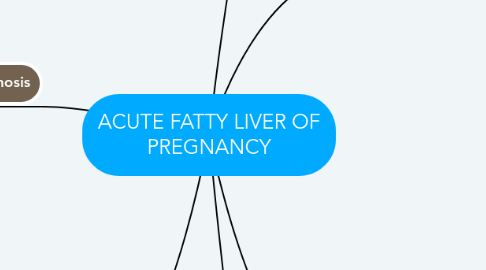
1. Diagnosis
1.1. Swansea criteria
1.1.1. 6 or more findings in the absence of another cause
1.1.1.1. Vomiting
1.1.1.2. Abdominal pain
1.1.1.3. Polydipsia/polyuria
1.1.1.4. Encephalopathy
1.1.1.5. High biliruibin (>14umol/L)
1.1.1.6. Hypoglycemia(<4mmol/L)
1.1.1.7. High uric acid (>340umol/L)
1.1.1.8. Leucocytosis (>11 X 10^6/L)
1.1.1.9. Ascites/ bright liver on ultrasound
1.1.1.10. High AST/ALT (>42IU/L)
1.1.1.11. High ammonia (>47umol/LO)
1.1.1.12. Renal impairment
1.1.1.12.1. Creatinine >150umol/L)
1.1.1.13. Coagulopathy
1.1.1.13.1. PT>14s
1.1.1.13.2. APTT>34s
1.1.1.14. Liverbiopsy
1.1.1.14.1. Microvesicular steatosis
1.2. Other potential findings
1.2.1. CT/ MRI Scan
1.2.1.1. Fatty infiltration of liver
2. Definition
2.1. A rare medical condition that commonly occurs in the third trimester of gestation.
2.1.1. 1 in 7,000 births
2.2. Microvesicular fatty infiltration of hepatocytes
2.2.1. Liver dysfunction
3. Signs and symptoms
3.1. Nausea
3.1.1. Anorexia
3.1.2. Vomiting
3.2. Hypoglycemia
3.3. Altered mental state
3.3.1. Confusion
3.3.2. Disorentation
3.3.3. Psychosis
3.4. Abdominal pain
3.4.1. Tenderness in right upper quadrant on palpation
3.5. Febrile
3.6. Hypertension
3.6.1. >140/90mmHg
4. Risk factors
4.1. Primigravidas
4.2. Multiple gestations
4.3. Co-existing diagnosis of other liver disorder
4.3.1. Pre-eclampsia
4.3.2. HELLP
4.3.2.1. Hemolysis
4.3.2.2. Elevated liver enzymes
4.3.2.3. Low platelets
4.4. Male fetus
4.5. Maternal genetic deficiency
4.5.1. Enzyme long-cahin-3-hydroxycacyl-CoA
4.6. Fetal genetic disorder
4.6.1. Mitochondrial fatty acid oxidation disorder
4.7. Third term gestation
5. Treatment
5.1. Curative
5.1.1. Prompt delivery of fetus and placenta
5.1.1.1. Vaginally
5.1.1.1.1. Induced
5.1.1.1.2. Naturally
5.1.1.2. Caesarean section
5.2. Stabilisation
5.2.1. Blood pressure
5.2.1.1. Antihypertensives
5.2.1.1.1. Oral
5.2.1.1.2. Intravenous
5.2.2. Blood glucose
5.2.2.1. 50% glucose supplement
5.2.3. Electrolyte balance
5.2.3.1. IV fluids
5.2.4. Coagulation
5.2.4.1. Plasma infusion
5.2.4.2. Albumin infusion
5.2.5. Admission to ICU
5.3. Preventative measures
5.3.1. Pancreatitis
5.3.1.1. Blood tests
5.3.1.1.1. Lipase
5.3.1.1.2. Amylase
5.3.1.2. CT scan
5.3.1.2.1. Focal or diffuse parenchymal enlargement
5.3.1.2.2. Pseudocytes
5.3.2. Infection
5.3.2.1. Broad spectrum antibiotics post caesarean
5.3.3. Poor mental health
5.3.3.1. Psychological/ counselling
6. Pathophysiology
6.1. Fetal mitochondrial fatty acid oxidation disorder
6.1.1. Hepatotoxic metabolites cross placenta and enter mothers circulatory system
6.1.1.1. Impairs mothers hepatic enzyme activity
6.1.1.1.1. Accumulation of hepatotoxic metabolites leads to liver damage
6.2. Maternal defficiency in long-chain 3-hydroxycacyl-CoA dehydrogenase
6.2.1. Decreased ability to break down fats
6.2.1.1. Accumulation of hepatotoxic metabolites
6.3. Environment stress
6.3.1. Diet high in fat
6.3.1.1. Accumulation of free fatty acids
6.4. Metabolic stress of third trimester
6.4.1. Decreased lipoprotein lipase activity

